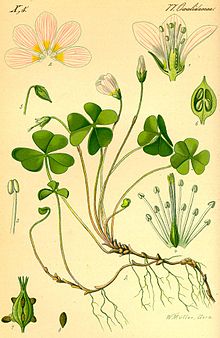- Common wood sorrel
-
Common wood sorrel 
Scientific classification Kingdom: Plantae (unranked): Angiosperms (unranked): Eudicots (unranked): Rosids Order: Oxalidales Family: Oxalidaceae Genus: Oxalis Species: O. acetosella Binomial name Oxalis acetosella
L.Common Wood-sorrel is a plant from the genus Oxalis, common in most of Europe and parts of Asia. The binomial name is Oxalis acetosella, because of its sour taste. In much of its range it is the only member of its genus and hence simply known as "the" wood-sorrel. It is also known as Alleluia, due to the fact that it blossoms between Easter and Pentecost, when the Psalms which end with Hallelujah were sung.
The plant has heart-shaped leaves, folded through the middle, that occur in groups of three atop a reddish brown stalk. It flowers for a few months during the spring, with small white flowers with pink streaks. Red or violet flowers also occur rarely. During the night or when it rains both flowers and leaves contract. Non-showy, cleistogamous flowers are produced during the summer.[1]
Wood sorrel has been eaten by humans for millennia. In Dr. James Duke's "Handbook of Edible Weeds," he notes that the Kiowa Indian tribe chewed wood sorrel to alleviate thirst on long trips, that the Potawatomi Indians cooked it with sugar to make a dessert, the Algonquin Indians considered it an aphrodisiac, the Cherokee tribe ate wood sorrel to alleviate mouth sores and a sore throat, and the Iroquois ate wood sorrel to help with cramps, fever and nausea.[2] Wood sorrel, like spinach and broccoli, contains oxalic acid which is considered slightly toxic because it interferes with food digestion and the absorption of some trace minerals. However, the U.S. National Institutes of Health have determined that the negative effects of oxalic acid are generally of little or no nutritional consequence in persons who eat a variety of foods.[3] An oxalate called "sal acetosella" was formerly extracted from the plant, through boiling.
The "Common wood sorrel" of North America is Oxalis montana, found from New England and Nova Scotia to Wisconsin and Manitoba and more unambiguously known as Mountain Wood-sorrel. It is similar to the species described above, but the petals are noticeably notched. It is called sours in the Northeast US.
The common wood sorrel is sometimes referred to as a shamrock (due to its three-leaf clover-like motif) and given as a gift on St. Patrick's Day.
References
- ^ Radford, A.E., H.E. Ahles, and C.R. Bell. 1964. Manual of the vascular flora of the Carolinas. Chapel Hill, NC: University of North Carolina Press.
- ^ http://books.google.com/books?id=rVrteo-8cI0C "Handbook of Edible Weeds" By James A. Duke, pp. 140-141
- ^ http://dietary-supplements.info.nih.gov/factsheets/calcium.asp "Other components in food: phytic acid and oxalic acid, found naturally in some plants, bind to calcium and can inhibit its absorption. Foods with high levels of oxalic acid include spinach, collard greens, sweet potatoes, rhubarb, and beans. Among the foods high in phytic acid are fiber-containing whole-grain products and wheat bran, beans, seeds, nuts, and soy isolates. The extent to which these compounds affect calcium absorption varies. Research shows, for example, that eating spinach and milk at the same time reduces absorption of the calcium in milk. In contrast, wheat products (with the exception of wheat bran) do not appear to have a negative impact on calcium absorption. For people who eat a variety of foods, these interactions probably have little or no nutritional consequence and, furthermore, are accounted for in the overall calcium DRIs, which take absorption into account."
External links
- Den virtuella floran: Oxalis acetosella (Swedish)
- Giftpflanzen.com — Waldsauerklee (German)
- oxalis-acetosella.com — Oxalis acetosella (German)
Categories:- Oxalis
- Medicinal plants
- Garden plants
- Hardwood forest plants
Wikimedia Foundation. 2010.

